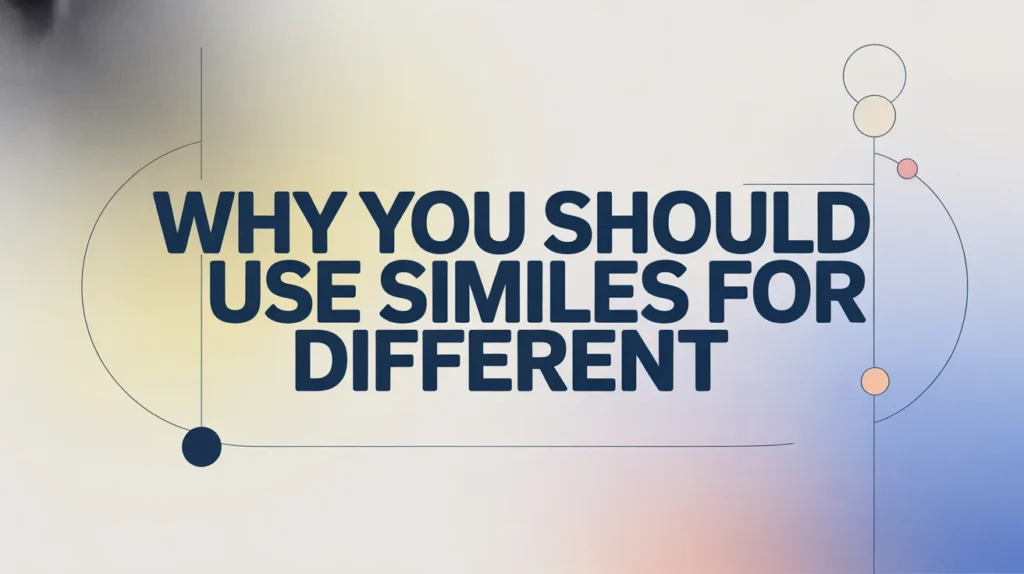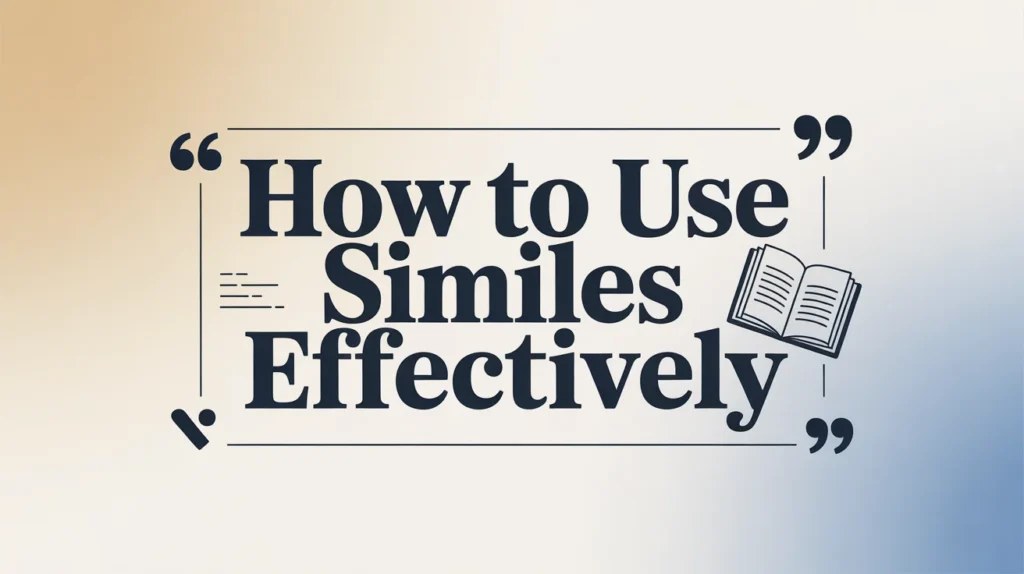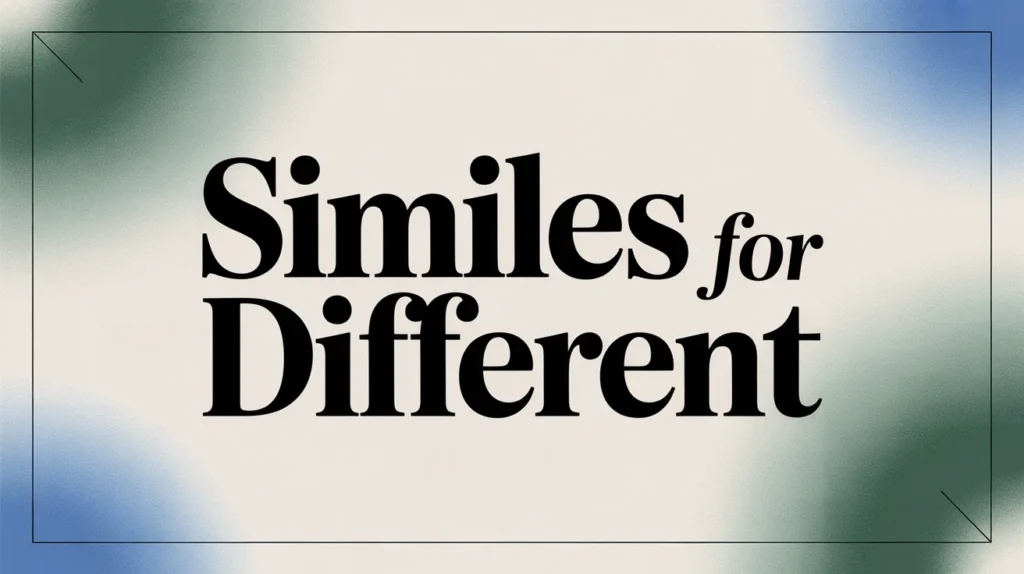In today’s world, being different is what makes life exciting. It’s what gives people, art, and ideas their spark. But sometimes, describing something “different” feels boring or repetitive. That’s where similes for different help.
A simile compares two things using “like” or “as.” It makes your message clear, colorful, and easy to imagine. Instead of saying, “She’s different,” you could say, “She’s as different as night and day.”
In this guide, we’ll explore dozens of creative similes for different, what they mean, and how you can use them to make your writing more expressive and human.
What Are Similes for Different?
Similes for “different” highlight contrast or uniqueness. They paint vivid pictures and make your writing come alive.
👉 Example: “He’s like chalk and cheese.” That means they’re completely opposite.
Why Writers Use Them
- They make your descriptions more visual.
- They help readers feel the difference.
- They add emotion and creativity.
- They turn plain sentences into something memorable.
Why You Should Use Similes for Different

When you use similes, you don’t just tell — you show. Instead of saying “They’re not alike,” you create a scene your readers can picture.
PurposeBenefitAdd imageryHelps readers visualize your idea.Increase impactMakes contrasts stronger.Improve toneAdds creativity and flow.Keep readers hookedMakes writing fun and relatable.
Example
❌ Their opinions were different. ✅ Their opinions were as different as summer and snow.
See how the second one instantly feels more alive?
Popular Similes for Different (With Meanings)
Here are some well-known, easy-to-use similes for “different,” along with what they mean.
SimileMeaningExampleAs different as night and dayTotal oppositesTheir styles are as different as night and day.Like chalk and cheeseCompletely unlikeThey’re twins but like chalk and cheese.As different as apples and orangesImpossible to compareThose two jobs are as different as apples and oranges.Like oil and waterDon’t mix or agreeTheir ideas were like oil and water.As different as fire and icePolar oppositesTheir tempers were as different as fire and ice.Like a square peg in a round holeDoesn’t fit inHe felt like a square peg in a round hole at work.As unique as a fingerprintOne of a kindHer art is as unique as a fingerprint.Like black and whiteClear contrastTheir lifestyles were like black and white.As rare as a blue moonExtremely unusualA voice like hers is as rare as a blue moon.Like a cat among pigeonsUncomfortable or disruptiveHis idea was like a cat among pigeons in the meeting.
Similes for Different Personalities
Use these similes to describe how people stand out or think differently.
- She’s as unpredictable as the weather.
- He’s like a puzzle no one can solve.
- Her laughter is like sunshine in winter.
- They’re as distinct as fingerprints.
- He’s as rare as a diamond in the dirt.
Each phrase gives personality and emotion to the description.
Similes for Different Appearances
When you want to describe how someone looks different, these similes help add color and imagery.
SimileMeaningExampleAs bright as a peacockColorful or flashyHer dress was as bright as a peacock.Like a star in the darkStands outHe shone like a star in the dark crowd.As strange as a two-headed coinVery unusualThat haircut was as strange as a two-headed coin.Like a zebra in a herd of horsesClearly differentShe stood out like a zebra in a herd of horses.As colorful as a painter’s paletteFull of varietyHis designs were as colorful as a painter’s palette.
Similes for Different Situations or Ideas
Sometimes, it’s not people who are different — it’s situations, opinions, or worlds.
- Their goals were as different as fire and ice.
- The two schools were like day and night.
- Their cultures blended like oil and water.
- The cities were as different as chaos and calm.
- Their methods were like puzzles from different boxes.
Each one helps you express diversity or contrast clearly.
Funny Similes for Different
Adding humor makes your writing more relatable. These funny similes are perfect for light, creative writing.
SimileMeaningExampleLike a penguin in the desertOut of placeHe looked like a penguin in the desert at that party.As odd as a square wheelWeird or sillyHer ideas are as odd as a square wheel.Like socks with sandalsMismatchedThat outfit was like socks with sandals.As strange as pineapple on pizzaOdd comboTheir friendship was as strange as pineapple on pizza.Like a fish in a treeDoesn’t belongHe’s like a fish in a tree in that office.
These make readers smile while clearly showing difference.
Unique and Creative Similes for Different
Want to sound original? Try these fresh similes instead of the old ones everyone uses.
- As different as galaxies apart.
- Like two colors from separate rainbows.
- As distinct as a snowflake’s pattern.
- Like poetry in a math book.
- As different as silence and thunder.
- Like wind trapped in a bottle.
- As different as sunrise and moonlight.
- Like dreams walking in daylight.
Perfect for poems, essays, or any creative project.
How to Use Similes for Different Effectively

Using similes well takes practice. Too many can overwhelm the reader; too few can make writing dull.
5 Quick Tips
- Keep them natural — don’t force comparisons.
- Match your tone — funny for humor, soft for emotion.
- Avoid clichés — use fresh imagery.
- Stay concise — short similes have more punch.
- Keep context in mind — make sure the reader understands the comparison.
Example
❌ He’s different like ground and sky. ✅ He’s as different as night and day.
The improved version flows smoothly and makes instant sense.
Similes for Different in Literature
Writers have used these comparisons for centuries. They make storytelling deeper and characters more vivid.
Examples from Common Usage:
- “As different as night and day.” — Expresses extreme contrast.
- “Like oil and water.” — Shows incompatibility.
- “As unique as a snowflake.” — Symbol of beauty and individuality.
You can use similar styles in essays, poems, or speeches.
Teaching and Learning with Similes
Similes are perfect for teaching creativity and figurative language. Teachers can use them in fun classroom exercises:
Activities
- Fill in the blank: They were as different as ____ and ____.
- Story writing: Ask students to describe two characters using similes.
- Group game: Match similes with their meanings.
This helps students learn how to think visually and creatively.
Quick Reference: Similes for Different
TypeExampleToneContrastAs different as night and dayNeutralOpposite personalitiesLike oil and waterConflictUniquenessAs rare as a blue moonAdmiringFunnyLike a penguin in the desertHumorousVisual differenceAs bright as a peacockDescriptiveEmotional differenceAs calm as still water vs. as fierce as firePoetic
FAQs
Q1: What does “similes for different” mean? It means using comparisons with “like” or “as” to show how two things contrast or stand apart.
Q2: Can I make my own similes? Yes! In fact, original similes sound more natural. For example: “As different as Wi-Fi and dial-up.”
Q3: How do similes help writing? They add emotion, color, and imagery — making your writing memorable and fun to read.
Q4: What’s the most common simile for different? “As different as night and day” is the classic one used everywhere.
Q5: Where can I use similes for different? In essays, creative writing, songs, speeches — anywhere you want to express individuality or contrast.
Conclusion
Being different isn’t strange — it’s beautiful. The right similes for different help you express that beauty clearly and creatively.
From “as different as fire and ice” to “like stars in daylight,” each comparison celebrates individuality. Whether you’re writing a poem, story, or speech, similes turn simple ideas into pictures that speak to the reader’s heart.

Emily Carter is a grammar coach and freelance writer with a deep love for the English language. She writes engaging lessons and tips on punctuation, spelling, and sentence structure to help learners communicate clearly and effectively.

